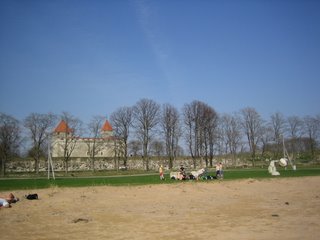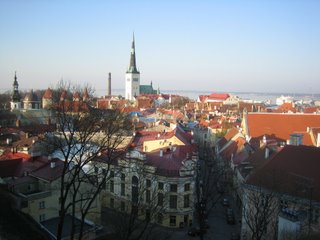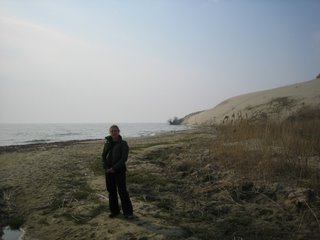Nabokov and the Sky
This is the main room on the first floor of the two-story town house Nabokov's family occupied until the revolution. Only the first floor is open to the public as a museum. The cases along the walls of this room are filled with original editions of his books and editions which were printed underground in the Soviet Union. Another room on the first floor, which served as the family library displays books from the Nabokov's collection. Nabokov specifically mentions growing up with some of these books in his autobiographical novel Speak Memory.
 The photos of Nabokov happily butterfly-hunting are hilarious and definitely a highlight of the museum.
The photos of Nabokov happily butterfly-hunting are hilarious and definitely a highlight of the museum. One of the rooms of the museum is devoted to "Vera's Butterflies". Nabokov dedicated all of his novels to his wife, Vera, and he'd sign her personal copy under the dedication always with a fanciful butterfly. Though based on real butterflies of specific genuses, Nabokov would elaborate on patterns and colors to create a personalized butterly and latinized genus-species name. He calls this one "Adorata adorata".
One of the rooms of the museum is devoted to "Vera's Butterflies". Nabokov dedicated all of his novels to his wife, Vera, and he'd sign her personal copy under the dedication always with a fanciful butterfly. Though based on real butterflies of specific genuses, Nabokov would elaborate on patterns and colors to create a personalized butterly and latinized genus-species name. He calls this one "Adorata adorata". This is Nabokov's scrabble board. Boris, this one's for you. I tried my hardest to channel its energy and will challenge anyone who steps up when I get home.
This is Nabokov's scrabble board. Boris, this one's for you. I tried my hardest to channel its energy and will challenge anyone who steps up when I get home.
I can't get over how strange the sky is here. Especially during the evening hours (which extend until about midnight at this point) the clouds look alive.
This photo is taken from the Lietenant Schmidt brigde, which is the bridge I often take home from the center of town. The tall cathedral is the Isaac Cathedral. At this time of day the city panorama reminds me of Budapest.
 I took this photo on my way out of a jazz club. It's about 10:15pm.
I took this photo on my way out of a jazz club. It's about 10:15pm. This is very close to where I live.
This is very close to where I live. Some Random Photos
Some Random Photos
The long awaited photo of Ira, my surrogate St. Petersburg Russian mother. She almost made me wait until she cut her hair, but I convinced to let me photograph her since you were all waiting. She is standing in front of the Isaac Cathedral, which we visited together last week. We climbed up to the terrace on the dome - one of the best views of the city. The statue of Czar Nicholas to Ira's right is famous for having all of its weight supported by the horse's hind legs. This doesn't need comment.
This doesn't need comment. These St. Petersburg citizens really love their parades. They had one on Saturday and one on Sunday for City Day, which celebrates St. Petersburg's birthday. This parade on Saturday along Nevsky Prospect featured floats from every neighborhood in the city along with huge floating advertisements of the companies and stores located in those neighborhoods.
These St. Petersburg citizens really love their parades. They had one on Saturday and one on Sunday for City Day, which celebrates St. Petersburg's birthday. This parade on Saturday along Nevsky Prospect featured floats from every neighborhood in the city along with huge floating advertisements of the companies and stores located in those neighborhoods.
 I am learning slowly what it means to be cool in St. Petersburg. The young men below are in my files. They are dancing in an "alternative" bar/club for the youngsters called "Novus". Meanwhile, I am sitting on a couch observing and taking notes on how to be cool.
I am learning slowly what it means to be cool in St. Petersburg. The young men below are in my files. They are dancing in an "alternative" bar/club for the youngsters called "Novus". Meanwhile, I am sitting on a couch observing and taking notes on how to be cool.
 The Church on Spilt Blood is the most ornate and colorful, inside and outside, of all of the St. Petersburg churches. From the outside it looks a bit like the Kremlin, though it's much smaller. Its name comes from the fact that it was built on the location of Alexander II's death (he was assasinated in a terrorist bomb attack). As you can see, one of the city's canals passes just along side it.
The Church on Spilt Blood is the most ornate and colorful, inside and outside, of all of the St. Petersburg churches. From the outside it looks a bit like the Kremlin, though it's much smaller. Its name comes from the fact that it was built on the location of Alexander II's death (he was assasinated in a terrorist bomb attack). As you can see, one of the city's canals passes just along side it. Located on Nevsky Prospect, this is the most beautiful supermarket I've ever seen. Unfortunately, Ira says it's threatening to close down because people aren't shopping here (since the products are the same as in other supermarkets, just more expensive).
Located on Nevsky Prospect, this is the most beautiful supermarket I've ever seen. Unfortunately, Ira says it's threatening to close down because people aren't shopping here (since the products are the same as in other supermarkets, just more expensive). Ira's brother and parents live in Kolpino, a town south of the city but still considered part of St. Petersburg, and they take trips there for the weekends to relax and get some family time. This weekend I went with them. The highlights of the trip were meeting Genya's adorable little cousin and his fiesty grandmother (she's exactly what you'd expect of an over 70 year-old still-working high school physical education teacher).
Ira's brother and parents live in Kolpino, a town south of the city but still considered part of St. Petersburg, and they take trips there for the weekends to relax and get some family time. This weekend I went with them. The highlights of the trip were meeting Genya's adorable little cousin and his fiesty grandmother (she's exactly what you'd expect of an over 70 year-old still-working high school physical education teacher). Below Genya and his little cousin, "Little Brother David", who is very charming and as instantly lovable and adorable as he looks. And I hate kids. Those little yellow-wrapped candies you can see near the pillow are my favorite Russian candies called "Korovka" or "Little Cow". They have a soft caramel center, but the outside is a slightly hardened, kind of grainy caramel reminiscent of hardened honey. They are amazing and so much better than all of the other chocolate-containing candies (all named after animals and Russian fairytale characters).
Below Genya and his little cousin, "Little Brother David", who is very charming and as instantly lovable and adorable as he looks. And I hate kids. Those little yellow-wrapped candies you can see near the pillow are my favorite Russian candies called "Korovka" or "Little Cow". They have a soft caramel center, but the outside is a slightly hardened, kind of grainy caramel reminiscent of hardened honey. They are amazing and so much better than all of the other chocolate-containing candies (all named after animals and Russian fairytale characters). On the way back from Kolpina Ira and I stopped at the monument-museum of the Siege of Leningrad. The monument you see in the photo below depicts a soldier on the left and a worker on the right. Together, the civilian and the soldier defended the city during the 900 day blockade, during which over 600,000 people died of hunger alone.
On the way back from Kolpina Ira and I stopped at the monument-museum of the Siege of Leningrad. The monument you see in the photo below depicts a soldier on the left and a worker on the right. Together, the civilian and the soldier defended the city during the 900 day blockade, during which over 600,000 people died of hunger alone.

 Some of the stations in the very center of the city which were created in the 70s have built-in platform doors that line up with those of the train when it pulls up to the station. I have no idea how these are more efficient or less expensive to produce (Ira said that was the original motivation) but I can see that people might have thought they were safer (Genya mentioned that drunkards often fall onto the tracks and die). Either way, they are very strange.
Some of the stations in the very center of the city which were created in the 70s have built-in platform doors that line up with those of the train when it pulls up to the station. I have no idea how these are more efficient or less expensive to produce (Ira said that was the original motivation) but I can see that people might have thought they were safer (Genya mentioned that drunkards often fall onto the tracks and die). Either way, they are very strange.






























